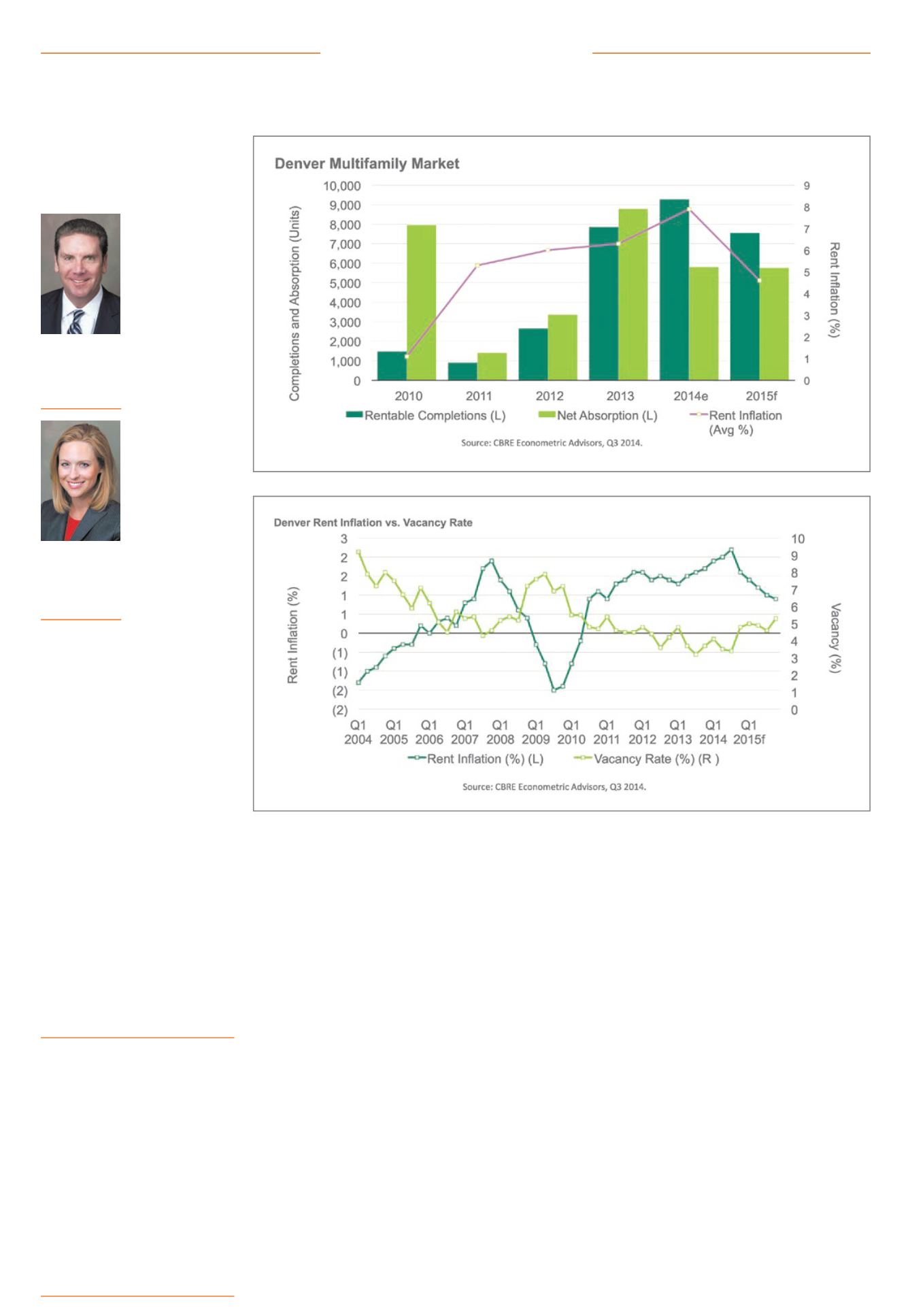

January 2015 — Multifamily Properties Quarterly —
Page 3
S
trong job and popula-
tion growth helped Denver
achieve a record year in the
multifamily sector in 2014.
Records were broken in aver-
age rent, occupancy, absorption and
rent growth. Which,
of course, led to
record construction
(over 19,000 units
currently). Can
2015 be as strong
as last year? Only
time will tell, but
our guess is it will
be one of solid per-
formance, strong
investor activity
and continued pos-
itive fundamentals.
Supply is high, but
so is demand. Most
of the construc-
tion is centered on
three areas: down-
town Denver, the
southeast business
corridor and the
northwest corridor.
All three areas are
major employ-
ment centers and
have connectivity
through current
or future light rail.
Denver is growing
up from the inside
out.
Denver, the 14th-
largest multifamily
market in the U.S. by existing units,
absorbed more than 8,100 units
over the past three quarters, plac-
ing it among the top 10 markets for
net absorption, according to CBRE
Econometric Advisors. As strong
demand outpaced new supply, the
metro vacancy rate registered a low
3.4 percent in third-quarter 2014,
down 30 basis points from a year
earlier, and well below the most
recent peak of 7.9 percent vacancy
in 2009.
This year, Denver will post its
strongest annual rent growth in
20 years of nearly 8 percent, beat-
ing the previous record year of
2000, when rent inflation reached
6.8 percent. Local rent growth also
outpaced most U.S. markets. Den-
ver ranks third in the U.S. for rent
growth over the past 12 months,
behind only Oakland and San Jose,
California.
The average apartment rent in
Denver as of third-quarter 2014
was $1,169 per month, according
to CBRE Econometric Advisors, and
rents in central Denver are 1.3 times
the market average. Rent growth
is expected to moderate in 2015 as
demand works to keep pace with
new deliveries, but will remain
above the historical average of 2.7
percent (1994-2014).
Apartment completions in 2014
will be second only to 2002, when
more than 10,000 units were deliv-
ered. Since 2010, central business
district apartment unit deliveries
have accounted for 20 percent of
all Denver completions, compared
with 12 percent in the 2000s and
5 percent in the 1990s. Apartment
Insights reports 19,900 units under
construction in Denver as of third-
quarter 2014 and another 20,100
planned or proposed. Further, 26
percent of the planned units are
located in Denver’s CBD.
The “millennial factor” has boost-
ed demand in Denver and contrib-
uted to upward rental rate pressure.
Denver ranks second in the U.S. for
growth in millennial population
between 2009 and 2012, according to
the Brookings Institute. Millennials
moved to Denver because of the job
availability and for the high quality
of life, and they bolstered occupancy
primarily in urban locations. The
shift of demand to the urban core
will help alleviate short-term soft-
ness in 2015.
A high volume of sales in the third
and fourth quarters most likely will
lead to a record year in 2014 once all
the sales are confirmed, surpassing
each of the past two years, which
have been very strong. Since 2011,
more than $9.1 billion in multifam-
ily assets have transacted in Denver,
according to Real Capital Analyt-
ics. 2015 is expected to be another
strong year of sales in Denver’s
multifamily sector, but likely more
reflective of 2011 or 2013 activity
levels. Investor interest spread to
secondary markets in 2014 and will
continue to seek yield in markets
like Boulder, Fort Collins and Colo-
rado Springs.
Pricing metrics have steadily
increased in Denver throughout the
current real estate cycle, but sig-
nificant increases were achieved in
2014. The average sales prices per
unit increased 31.8 percent year
over year in third-quarter 2014 to
$149,000. Third-quarter 2014 also
marked the fourth consecutive
quarter Denver’s average sales price
per unit exceeded the U.S., which
is the longest running overage on
record. Cap rates compressed a bit
in 2014, ranging from the low-6 per-
cents to the high-4 percents (for tro-
phy assets in prime locations). As of
third-quarter 2014, the cap rate for
all multifamily product registered
6.1 percent, according to Real Capi-
tal Analytics.
Looking ahead, potential head-
winds that will impact the market
in the near term include a revision
to Colorado’s construction defect
laws in 2015. This may pave the way
for more condominium construc-
tion, thereby providing multifam-
ily dwellers more options to own
instead of rent. However, it will be a
while before this takes effect. Resur-
gence in single-family construction
is also expected in 2015-2016, pro-
viding additional options for Den-
ver’s growing number of households.
Lastly, are interest rates finally
going up this year? If they do, it will,
at the very least, cause a temporary
pause in activity, but most likely will
not greatly impact fundamentals as
long as the increases are slow.
The big question is where are we
in this cycle? Only one thing is cer-
tain: Cycles rarely repeat exactly as
those before. Are we in the seventh
inning? Most likely, but it may be an
extra-inning game. Whatever your
analogy, we are in a good place right
now and as long as job growth and
population growth continue, Denver
should continue to perform well
and see prolonged interest from the
investor world. Investors are par-
ticularly attracted to Denver’s strong
employment and demographic
growth, as well as the mass transit
infrastructure improvements and
diverse industry base. Denver is truly
one of the top non-coastal markets
in terms of both attractiveness to job
seekers and investors.
s
2015 multifamily outlook: how it affects DenverMultifamily Overview
David Potarf
Senior vice
president,
Investment
Properties, CBRE,
Denver
Jessica
Ostermick,
LEED AP
Director, Research
& Analysis, CBRE,
Greenwood Village
The ‘millennial
factor’ has
boosted demand
in Denver and
contributed to
upward rental
rate pressure.
















